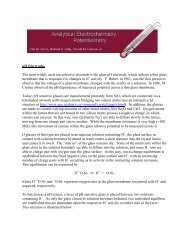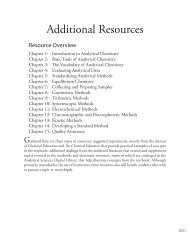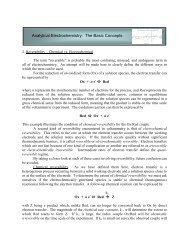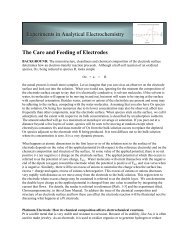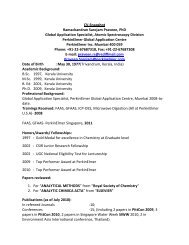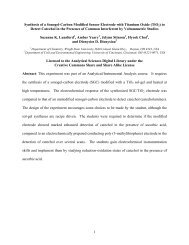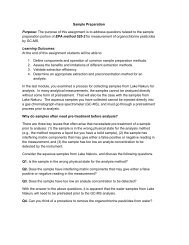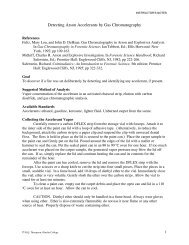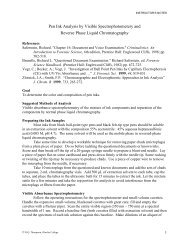5. Analysis of Trace Lead in Water by Anodic Stripping Voltammetry ...
5. Analysis of Trace Lead in Water by Anodic Stripping Voltammetry ...
5. Analysis of Trace Lead in Water by Anodic Stripping Voltammetry ...
Create successful ePaper yourself
Turn your PDF publications into a flip-book with our unique Google optimized e-Paper software.
with standard solutions <strong>of</strong> known quantities <strong>of</strong> metal ions. Besides determ<strong>in</strong><strong>in</strong>g which metals are present,the quantity <strong>of</strong> each metal can be correlated to the peak height <strong>of</strong> the current or the <strong>in</strong>tegrated chargeunder the peak.-165D-145-125-105AB100 ppb200 ppbCurrent, µA-85-65CCD500 ppb1000 ppb-45-25BA-5Potential, mV vs Ag/AgCl reference electrodeFigure 1. L<strong>in</strong>ear scan ASV <strong>of</strong> Pb us<strong>in</strong>g a th<strong>in</strong> Hg film electrode on glassy carbon. Experimentalconditions: deposition time 2.0 m<strong>in</strong>utes a with 30 second rest period before scann<strong>in</strong>g. Initialpotential at -1,000 mV and f<strong>in</strong>al potential at +200 mV. Scan rate = 2 V/s with the Hg film codepositedwith Pb dur<strong>in</strong>g the deposition step. Data files were exported to Excel and plotted withthe potential scale set from –200 to –600 mV. If you are unfamiliar with the use <strong>of</strong> Excelprogram, please consult the Technical Note on Excel <strong>in</strong> this eChem Manual.ASV was orig<strong>in</strong>ally developed with a hang<strong>in</strong>g Hg drop electrode where the metals <strong>of</strong>ten form anamalgam. However, to limit the quantity <strong>of</strong> toxic Hg used, th<strong>in</strong> Hg films can be pre-deposited onto anelectrode such as glassy carbon or co-deposited simultaneously with the analyte metal ions. The amount<strong>of</strong> Hg deposited is very little and can be readily removed at potentials less negative than those <strong>of</strong> theanalyte metals, such as Pb, Cd and Cu. References 1-5 <strong>in</strong>clude web-based onl<strong>in</strong>e ASV articles andhardcopy references on the subject.EXPERIMENT-600 -500 -400 -300 -200Equipment• Use an analog or computer-controlled potentiostat with appropriate data acquisition equipmentfor this experiment (ask your lab <strong>in</strong>structor for directions on use <strong>of</strong> potentiostat)• Electrochemical cell and electrodeso Small volume cello 1.0 mm or 3.0 mm flat tipped glassy carbon electrodeo Pt auxiliary electrodeo Ag/AgCl reference electrodeo Polish<strong>in</strong>g kit• A magnetic stirrer and a small bar <strong>in</strong>side the cell2



